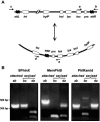Mosaic prophages with horizontally acquired genes account for the emergence and diversification of the globally disseminated M1T1 clone of Streptococcus pyogenes
- PMID: 15866915
- PMCID: PMC1112019
- DOI: 10.1128/JB.187.10.3311-3318.2005
Mosaic prophages with horizontally acquired genes account for the emergence and diversification of the globally disseminated M1T1 clone of Streptococcus pyogenes
Abstract
The recrudescence of severe invasive group A streptococcal (GAS) diseases has been associated with relatively few strains, including the M1T1 subclone that has shown an unprecedented global spread and prevalence and high virulence in susceptible hosts. To understand its unusual epidemiology, we aimed to identify unique genomic features that differentiate it from the fully sequenced M1 SF370 strain. We constructed DNA microarrays from an M1T1 shotgun library and, using differential hybridization, we found that both M1 strains are 95% identical and that the 5% unique M1T1 clone sequences more closely resemble sequences found in the M3 strain, which is also associated with severe disease. Careful analysis of these unique sequences revealed three unique prophages that we named M1T1.X, M1T1.Y, and M1T1.Z. While M1T1.Y is similar to phage 370.3 of the M1-SF370 strain, M1T1.X and M1T1.Z are novel and encode the toxins SpeA2 and Sda1, respectively. The genomes of these prophages are highly mosaic, with different segments being related to distinct streptococcal phages, suggesting that GAS phages continue to exchange genetic material. Bioinformatic and phylogenetic analyses revealed a highly conserved open reading frame (ORF) adjacent to the toxins in 18 of the 21 toxin-carrying GAS prophages. We named this ORF paratox, determined its allelic distribution among different phages, and found linkage disequilibrium between particular paratox alleles and specific toxin genes, suggesting that they may move as a single cassette. Based on the conservation of paratox and other genes flanking the toxins, we propose a recombination-based model for toxin dissemination among prophages. We also provide evidence that a minor population of the M1T1 clonal isolates have exchanged their virulence module on phage M1T1.Y, replacing it with a different module identical to that found on a related M3 phage. Taken together, the data demonstrate that mosaicism of the GAS prophages has contributed to the emergence and diversification of the M1T1 subclone.
Figures





References
-
- Anthony, B. F., E. L. Kaplan, L. W. Wannamaker, and S. S. Chapman. 1976. The dynamics of streptococcal infections in a defined population of children: serotypes associated with skin and respiratory infections. Am. J. Epidemiol. 104:652-666. - PubMed
-
- Aziz, R. K., S. A. Ismail, H. W. Park, and M. Kotb. 2004. Post-proteomic identification of a novel phage-encoded streptodornase, Sda1, in invasive M1T1 Streptococcus pyogenes. Mol. Microbiol. 54:184-197. - PubMed
-
- Banks, D. J., S. B. Beres, and J. M. Musser. 2002. The fundamental contribution of phages to GAS evolution, genome diversification and strain emergence. Trends Microbiol. 10:515-521. - PubMed
-
- Beres, S. B., G. L. Sylva, K. D. Barbian, B. Lei, J. S. Hoff, N. D. Mammarella, M. Y. Liu, J. C. Smoot, S. F. Porcella, L. D. Parkins, D. S. Campbell, T. M. Smith, J. K. McCormick, D. Y. Leung, P. M. Schlievert, and J. M. Musser. 2002. Genome sequence of a serotype M3 strain of group A streptococcus: phage-encoded toxins, the high-virulence phenotype, and clone emergence. Proc. Natl. Acad. Sci. USA 99:10078-10083. - PMC - PubMed
Publication types
MeSH terms
Substances
Grants and funding
LinkOut - more resources
Full Text Sources
Medical
Molecular Biology Databases

